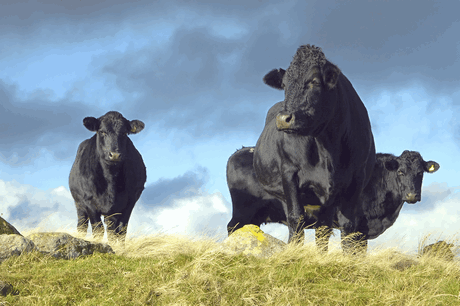SAC shows outwintering sucklers can cut costs if the climate is right

Outwintering suckler cows could be saving £40-£60 a cow over winter compared to housed cattle, suggest industry figures.
The beef industry continues to look at ways cows can be kept that cheapen the cost, says Gavin Hill, SAC project leader. “One potential area to save costs is developing systems for outwintering stock. Simple savings can be made by not having to feed concentrates, not needing fixed equipment, shed space or bedding.
“Obviously not every farm is suited to outwintering as appropriate environmental conditions are needed. Farmers should take particular care if they are in any environmental schemes, having appropriate management in place to avoid problems such as poaching.
One farmer closely involved in the SAC/QMS outwintering project is David Kirkpatrick of Auchenbainzie Farm, Dumfries. The 857ha (2117-acre) farm, split between hill and upland grazing with land ranging from 60m to 300m, grazes a mix of Angus cross and Stabiliser cross cows.

Under the trial, two 100ha (247-acre) hill areas containing molinia/ bent meadowgrass, fescue and heather, hold 66 cows, with a stocking density of 1-1.5 cows/ha (1 cow to 3.8 acres).
Currently outwintering costs are estimated at £0.28 a day, compared to indoor cows costing £0.85 a day. “This equates to £0.57 a day or £57 saving over 100 days,” says Mr Kirkpatrick.
“Not having to pay contractors for silage making, having silage pasture available in summer, combined with not having manual upkeep of housing and bedding, is where savings have been made.
“This has been an interesting and valuable exercise as previous SAC work has shown deferred grazing savings to only be available for a defined period, as additional feed is usually needed after New Year.
“Although this has been the case as the quality of grass deteriorates post-December, it is still more cost-efficient to supplement feed outdoors than winter cows indoors.
“The loss in condition of outwintered cows has been in line with previous years and at this time limited falls are wanted. However, despite some condition loss (0.25kg/day versus 0.21kg/day, Angus and Stabiliser) half the cows returned to the hill.
The 61 cows with a condition score less than 2.5 were put on kale. Due to poor kale yield, the other 71 cows were placed back on the hill and fed high-energy feed blocks and then changed to cobs at the end of January.
“Due to the success of extending outwintering this year we plan to follow the same practices next year, extending outwintering from three to four months.
“Cows will also calve outside as I have confidence with the Stabilisers’ ability to calve. Calving has partly been eased by growing fitness and muscle tone of cows outwintered.
“In terms of environment, naturalists approve as the hills are left fallow through the second half of the summer allowing ground nesting birds to breed. And in terms of poaching, moving feeding spots daily prevents this occurring.
“A cow’s natural habitat is outdoors. Outwintering is a win-win situation, minimising housing costs and maximising cow’s welfare.
Outwintering
- Minimises housing cost
- Maximises welfare
- Environmentally viable
